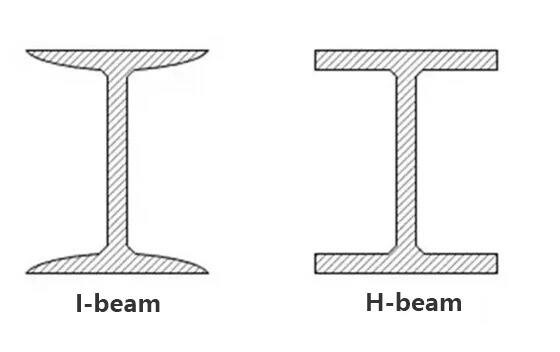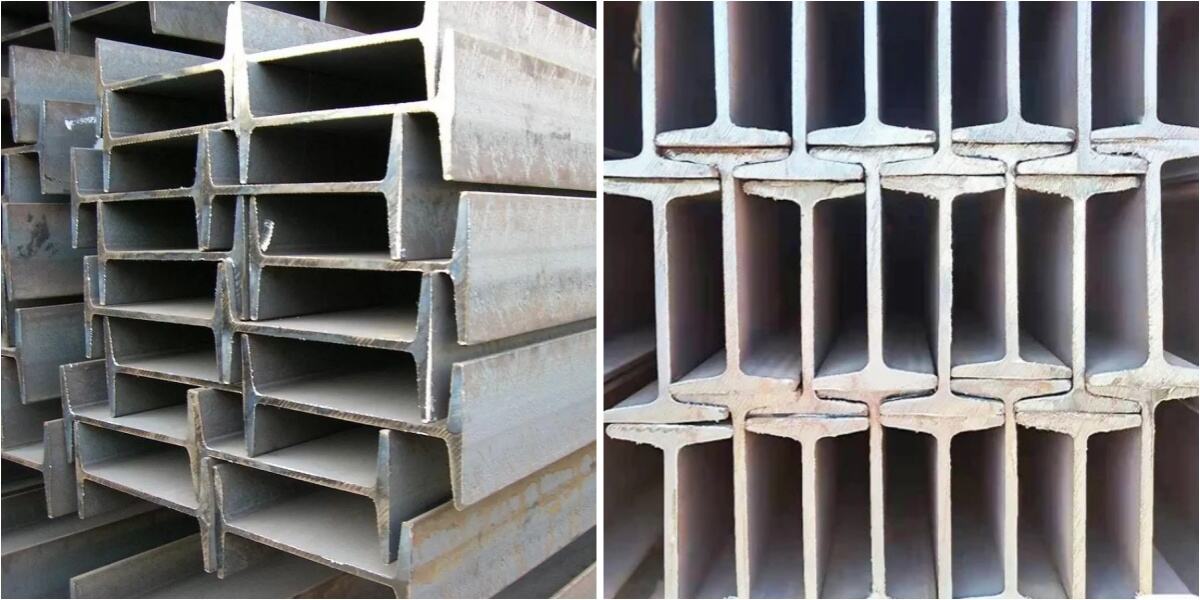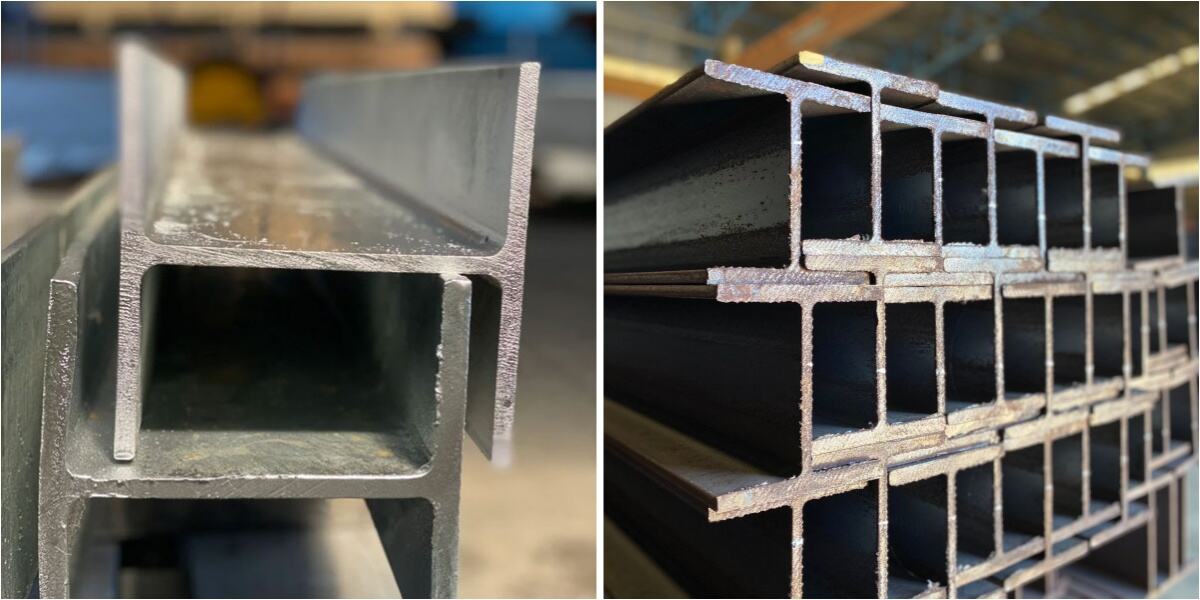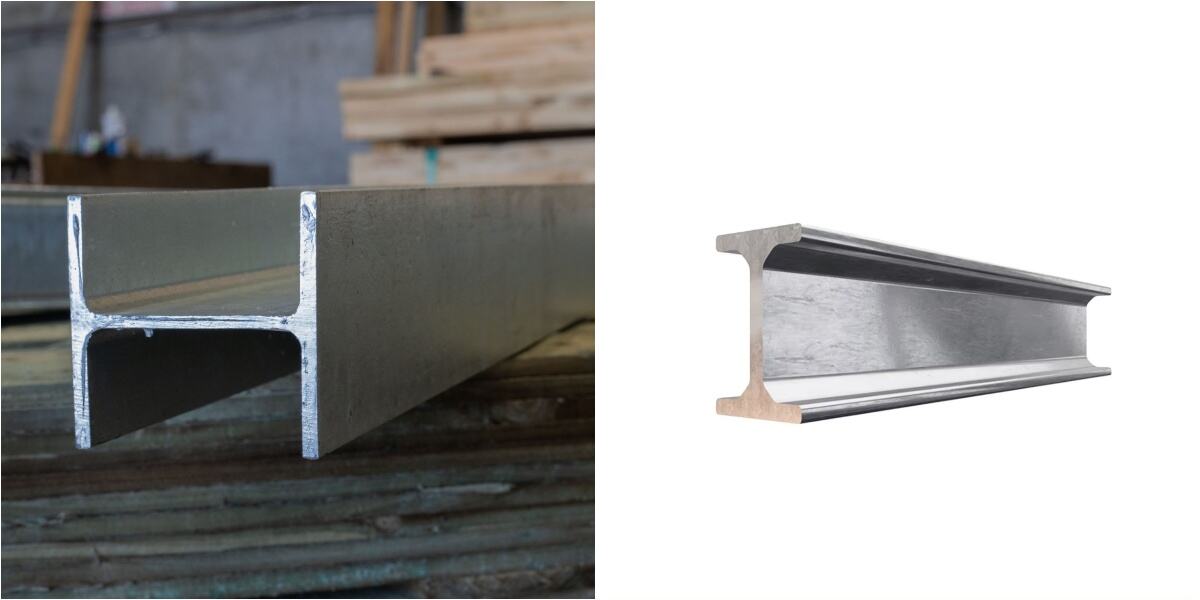Le persone spesso chiedono come scegliere tra I-beam e I-beam , che sono simili in forma?
Molte persone pensano che I-beam sia il nome in Cina e H-beam sia il nome all'estero. In realtà, questa percezione è errata. H-beam e I-beam sono diversi in forma, come mostrato nella figura qui sotto:

Cos'è un I-beam?
Fuoco I viene anche chiamato travetto d'acciaio, e la sua sezione trasversale ha la forma della lettera "I". Il suo bordo è simile a quello del H-beam, ma l'anima dell'I-beam è solitamente più sottile di quella del H-beam, e il bordo è relativamente stretto.
La trave a I è principalmente divisa in trave a I normale, trave a I leggera e trave a I a flange larghe. In base al rapporto tra la flangia e l'altezza del piano, viene divisa in trave a I a flange larghe larghe, medie e strette. Le specifiche delle prime due sono da 10 a 60, cioè l'altezza corrispondente è da 10 a 60 cm.
Allo stesso livello di altezza, la trave a I leggera ha una flangia stretta, un piano sottile e un peso leggero. La trave a I a flange larghe viene anche chiamata trave a H. La sua sezione è caratterizzata da due gambe parallele e da nessuna inclinazione sul lato interno delle gambe. È un acciaio con sezione economica e viene laminato su un laminatore universale a quattro rulli, quindi viene anche chiamata "trave a I universale". Le travi a I normali e leggere hanno formato standard nazionale.
Come suggerisce il nome, il fermo è un'acciaio con sezione a "I". La superficie interna delle ali superiori e inferiori ha un'inclinazione generalmente di 1:6, il che rende l'ala sottile all'esterno e spessa all'interno. Di conseguenza, le caratteristiche della sezione del fermo nei due piani principali sono molto diverse, e risulta difficile far emergere le caratteristiche di resistenza dell'acciaio nell'applicazione. Sebbene si siano visti anche fermi ispessiti nel mercato dei fermi, la struttura del fermo determina i suoi limiti nella prestazione torsionale.

Cos'è un fermo H?
Il fermo H è un'acciaio con una sezione a "H", composta principalmente da due ali parallele e da un'anima verticale.
Lo acciaio a forma di H è un profilo economico ed efficiente con una distribuzione della sezione trasversale più ottimizzata e un rapporto forza-peso più ragionevole. Prende il nome dal fatto che la sua sezione trasversale è uguale alla lettera inglese "H". Poiché tutte le parti dello acciaio a H sono disposte ad angolo retto, esso ha i vantaggi di una forte resistenza alla flessione, costruzione semplice, risparmio di costi e peso strutturale leggero in tutte le direzioni, ed è stato ampiamente utilizzato.
Lo acciaio a H è un profilo ampiamente utilizzato negli edifici in acciaio delle strutture d'oggi. Ha molte differenze rispetto all'acciaio a I. Primo, l'alare, e in secondo luogo, la superficie interna dell'alare non ha inclinazione, e le superfici superiori e inferiori sono parallele. Le caratteristiche della sezione trasversale dello acciaio a H sono significativamente migliori rispetto all'acciaio tradizionale a I, a U e a L.
I lati interni delle due bordature esterne dell'acciaio a forma di H non hanno inclinazione e sono retti. Ciò rende il saldatura e l'assemblaggio dell'acciaio a H più semplici rispetto a quello a I, e le proprietà meccaniche per unità di peso sono migliori, il che può risparmiare molto materiale e tempo di costruzione. La sezione trasversale dell'acciaio a I è efficace nella resistenza diretta alla compressione e al tractione, ma la dimensione della sezione non può resistere alla torsione poiché l'alama è troppo stretta. L'acciaio a H è il contrario, e ciascuno ha i propri vantaggi e svantaggi.

Come Distinguere un Travetto a I da uno a H in Base al loro Aspetto?
I travetti a I (travetti a I) e quelli a H differiscono notevolmente nell'aspetto, soprattutto nelle forme delle sezioni trasversali. Ecco le principali differenze di aspetto tra i due tipi di acciaio:
- Trave a I (acciaio a sezione I): La sezione trasversale della trave a I ha la forma della lettera "I". In particolare, la sezione trasversale di una trave a I è composta da un telaio verticale (parte centrale) e due ali orizzontali (parti superiore e inferiore). Le ali sono generalmente strette e il telaio è sottile, quindi la forma complessiva della sezione trasversale assomiglia a una "I" semplificata.
-
Trave a H: La sezione trasversale della trave a H ha la forma della lettera "H", ed è anch'essa composta da un telaio e da ali. Tuttavia, a differenza della trave a I, l'ala della trave a H è più larga e spessa di quella della trave a I, e il telaio è relativamente più sottile.

Travi a H vs Travi a I
Che cos'è La Differenza Tra Trave a H e Trave a I ?
indipendentemente dal fatto che sia normale o leggera, la sezione a I ha una dimensione incrociata relativamente alta e stretta, quindi il momento di inerzia dei due assi principali della sezione è abbastanza diverso. Pertanto, può generalmente essere utilizzata solo direttamente per elementi piegati nel piano della falda o per formare un elemento portante a griglia. Non è adatta per elementi compressi assialmente o per elementi piegati perpendicolarmente al piano della falda, il che ne limita grandemente l'ambito di applicazione.
2. La sezione a H è un profilo ad alta efficienza e economico (altri includono acciaio sottile piegato a freddo, lastre d'acciaio ondulate, ecc.). A causa della forma ragionevole della sezione, permettono di rendere l'acciaio più efficiente e migliorare la capacità di taglio. A differenza delle normali travi a I, le ali delle travi a H sono allargate e le superfici interne ed esterne sono generalmente parallele, il che facilita la connessione con altri componenti tramite viti autoforanti ad alta resistenza. Le sue dimensioni costituiscono una serie ragionevole e i modelli sono completi, il che rende facile la progettazione e la selezione (eccetto per le travi a I per le travi dei gru).
3. Le ali dell'acciaio a H sono di spessore uniforme. Esistono sezioni laminate e sezioni composte formate da tre piastre saldate insieme. L'acciaio a I è una sezione laminata. A causa di una tecnologia di produzione non ottimale, il bordo interno delle ali ha una pendenza di 1:10. La laminatura dell'acciaio a H è diversa da quella dell'acciaio a I tradizionale, che utilizza solo un set di rulli orizzontali. Poiché le sue ali sono larghe e non hanno pendenza (o la pendenza è molto piccola), è necessario aggiungere un set di rulli verticali per la laminatura contemporanea. Pertanto, il suo processo di laminazione e l'attrezzatura sono più complessi rispetto ai laminatoi tradizionali. L'altezza massima dell'acciaio a H laminato che può essere prodotto in Cina è di 800mm. Se supera questo limite, può essere solo una sezione combinata saldata.
4. La lunghezza laterale dell'acciaio a I è piccola e l'altezza è grande, quindi può resistere solo a forze in una direzione.
5. Il profilo a H è profondo e spesso, e può resistere a forze in due direzioni.
6. Con lo sviluppo degli edifici in acciaio, non è sufficiente utilizzare solo l'acciaio a I. In altre parole, l'acciaio a I spesso tende a diventare instabile quando viene utilizzato come colonna portante.
7. Le travi a I possono essere utilizzate solo come travi, mentre le travi a H possono essere utilizzate come colonne portanti delle strutture.
8. Le travi a H sono un tipo di acciaio con sezione economica e hanno proprietà meccaniche della sezione migliori rispetto alle travi a I. Sono chiamate così perché la forma della loro sezione ricorda la lettera inglese "H". La falda delle travi a H ottenute con laminazione calda è più larga rispetto a quella delle travi a I, offrendo una maggiore rigidità trasversale e una resistenza al flessione superiore. Nello stesso formato, il peso delle travi a H è inferiore a quello delle travi a I.
9. La falda delle travi a I ha una sezione variabile, più spessa vicino alla cassettina e più sottile all'esterno; la falda delle travi a H ha una sezione uniforme.
10. HW, HM e HN sono i nomi generali per le travi a H. Le travi a H vengono saldate; HW, HM e HN sono ottenute con laminazione calda.
11.HW è un fermo H con in genere altezza e larghezza della lamiera uguali; viene utilizzato principalmente per colonne a nucleo d'acciaio nelle strutture a telaio di calcestruzzo armato, note anche come colonne rigide in acciaio; viene utilizzato principalmente per le colonne nelle strutture in acciaio.
12.HM è il rapporto tra l'altezza del fermo H e la larghezza della lamiera di circa 1.33~1.75; utilizzato principalmente nelle strutture in acciaio: usato come colonne portanti in acciaio, e come travi del telaio in strutture a telaio che supportano carichi dinamici. Ad esempio: piattaforme per impianti.
13.HN è il rapporto tra l'altezza del fermo H e la larghezza della lamiera maggiore o uguale a 2, utilizzato principalmente per le travi; l'uso delle travi I è equivalente alle travi HN.
Siamo un produttore professionista di acciaio. Se hai bisogno, puoi contattarci in qualsiasi momento!
 +86 17611015797 (WhatsApp )
+86 17611015797 (WhatsApp )  info@steelgroups.com
info@steelgroups.com
